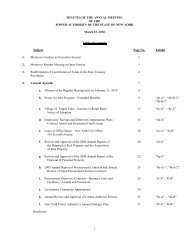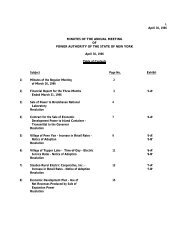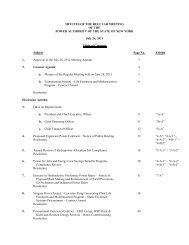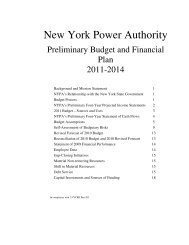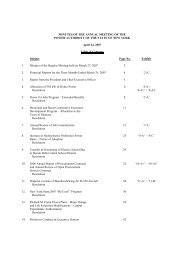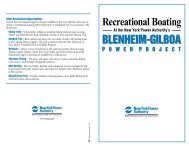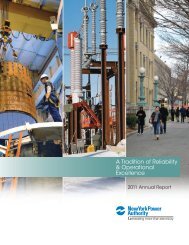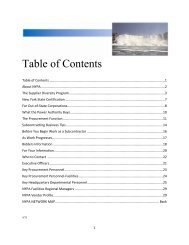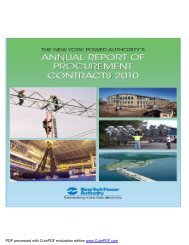July (pdf) - New York Power Authority
July (pdf) - New York Power Authority
July (pdf) - New York Power Authority
You also want an ePaper? Increase the reach of your titles
YUMPU automatically turns print PDFs into web optimized ePapers that Google loves.
could potentially result in significant additional costs and operational restrictions on hydroelectric generating<br />
facilities located within the range of the species, including the <strong>Authority</strong>’s St. Lawrence-FDR Project.<br />
There is concern by individuals, the scientific community and Congress regarding possible<br />
environmental damage resulting from the use of fossil fuels. The <strong>Authority</strong>’s 500-MW Plant, Flynn plant and<br />
its SCPPs use fossil fuels as does the Astoria Energy II plant. Congressional and regulatory action for the<br />
increased regulation of air, water and contaminants is periodically considered, and there are a number of<br />
pending or enacted legislative proposals which may affect the electric utility industry. The impact on the<br />
<strong>Authority</strong>’s operations of any such laws or regulations is not presently predictable or quantifiable.<br />
[update further] On March 10, 2005, the U.S. Environmental Protection Agency (“EPA”) issued the<br />
Clean Air Interstate Rule (“CAIR”), which seeks to achieve the largest reduction in air pollution in more<br />
than a decade, using a cap and trade system to reduce emissions of sulfur dioxide (SO 2 ) and nitrogen oxides<br />
(NOX) in the eastern United States. The CAIR allowances consist of SO 2 , annual NOX, and ozone season<br />
NOX allowances. On <strong>July</strong> 11, 2008, the U.S. Court of Appeals for the D.C. Circuit issued an opinion<br />
finding several flaws in the CAIR, vacated the rule and remanded the matter to the EPA. The EPA<br />
petitioned the Court for relief and the Court granted a remand without vacatur on December 23, 2008.<br />
This ruling by the Court leaves CAIR and the CAIR Federal Implementation Plans, including the CAIR<br />
trading programs, in place until EPA issues a new rule to replace CAIR. Accordingly, the previous<br />
allowance allocations continued to be valid until the CAIR rules are replaced. The <strong>Authority</strong> has been<br />
able to operate its fossil units within the limits of the allocated allowances.<br />
[update further] On <strong>July</strong> 6, 2010, the EPA proposed the Transport Rule, which was promulgated to<br />
address the Court’s opinion and remand of CAIR. Once approved, the Transport Rule would replace<br />
CAIR. The impact on the <strong>Authority</strong>’s operations of the Transport Rule cannot be fully predicted at the<br />
present time; however, it is expected that the allocation of allowances will not impact operation of the<br />
500-MW Plant or the SCPPs, but may affect the Flynn Plant.<br />
The Regional Greenhouse Gas Initiative (‘‘RGGI’’) is a cooperative effort by Northeastern and<br />
Mid-Atlantic states (including <strong>New</strong> <strong>York</strong>) to hold carbon dioxide emission levels steady from 2009 to<br />
2014 and then reduce such levels by 2.5% annually in the years 2015-2018 for a total 10% reduction.<br />
Central to this initiative is the implementation of a multi-state cap-and-trade program with a market-based<br />
emissions trading system. The program requires electricity generators to hold carbon dioxide allowances<br />
in a compliance account in a quantity that matches their total emissions of carbon dioxide for the<br />
compliance period. The <strong>Authority</strong>’s Flynn, SCPPs, and 500-MW Plant are subject to the RGGI<br />
requirements as is the Astoria Energy II plant. The <strong>Authority</strong> has participated in program auctions<br />
commencing September 2008 and expects to recover RGGI costs through its power sales revenues. The<br />
<strong>Authority</strong> is monitoring federal legislation and proposed programs that would impact RGGI.<br />
Other Factors<br />
The electric utility industry in general has been, and in the future may be, affected by a number of<br />
other factors which could impact the financial condition and competitiveness of many electric utilities,<br />
including the <strong>Authority</strong>, and the level of utilization of their generating and transmission facilities.<br />
Electric and magnetic fields (‘‘EMF’’) exist wherever electricity flows, around high voltage transmission<br />
and distribution equipment (‘‘power Frequency EMF’’), as well as near electrical appliances, computers, and<br />
other electrical devices. Epidemiological studies, clinical studies and laboratory experiments have shown that<br />
EMF can cause changes in living cells, but there is little evidence that these changes suggest any risk to<br />
human health.<br />
2-47



